2002 MERCEDES-BENZ G500 driver seat adjustment
[x] Cancel search: driver seat adjustmentPage 4 of 385

1 Contents
IntroductionProduct information .......................... 7
Roadside assistance ......................... 10
Where to find it ................................ 14
Reporting Safety Defects ................ 16Instruments and controlsInstruments and controls ............... 18
Center console .............................. 20
Door control panel ....................... 22
Overhead control panel ............... 23OperationVehicle keys ...................................... 26
Start lock-out .................................... 28
General notes on the
central locking system ............... 28
Central locking system ................... 29
Radio frequency and
infrared remote control ............... 29
Locking and unlocking ................ 31Choosing global or
selective mode on
remote control ...............................31
Opening and closing windows
and sliding / pop-up roof
from outside ................................. 32
Panic button ................................. 33
Mechanical keys .......................... 33
Doors ................................................. 34
Locking and unlocking
driver’s door manually ............... 36
Tailgate .............................................. 37
Locking and unlocking
the tailgate manually .................. 38
Locking the tailgate separately . 39
Central locking switch .................... 40
Automatic central locking ............... 41
Emergency unlocking in
case of accident ........................... 41
Antitheft alarm system ................... 42
Tow-away alarm ............................... 43
Easy-entry/exit feature .................. 44
Front seat adjustment ..................... 45Synchronizing head restraints
and seat adjustment fore, aft ..... 47
Removal and installation of
front seat head restraints .......... 51
Seat heater, front ............................. 52
Seat heater, rear ............................... 54
Seat belts and
integrated restraint system ....... 56
Seat belts ........................................... 56
Seat belt nonusage
warning system ............................ 57
BabySmart
TM airbag
deactivation system .................... 63
Self-test BabySmart
TM without
special child seat installed ........ 63
Supplemental restraint system
(SRS) ............................................. 64
Emergency tensioning retractor
(ETR) ............................................. 65
Airbags .............................................. 66
Safety guidelines for the
seat belt, emergency
tensioning retractor and
airbag ............................................ 71
J_G463.book Seite 1 Mittwoch, 19. September 2001 8:06 08
Page 27 of 385
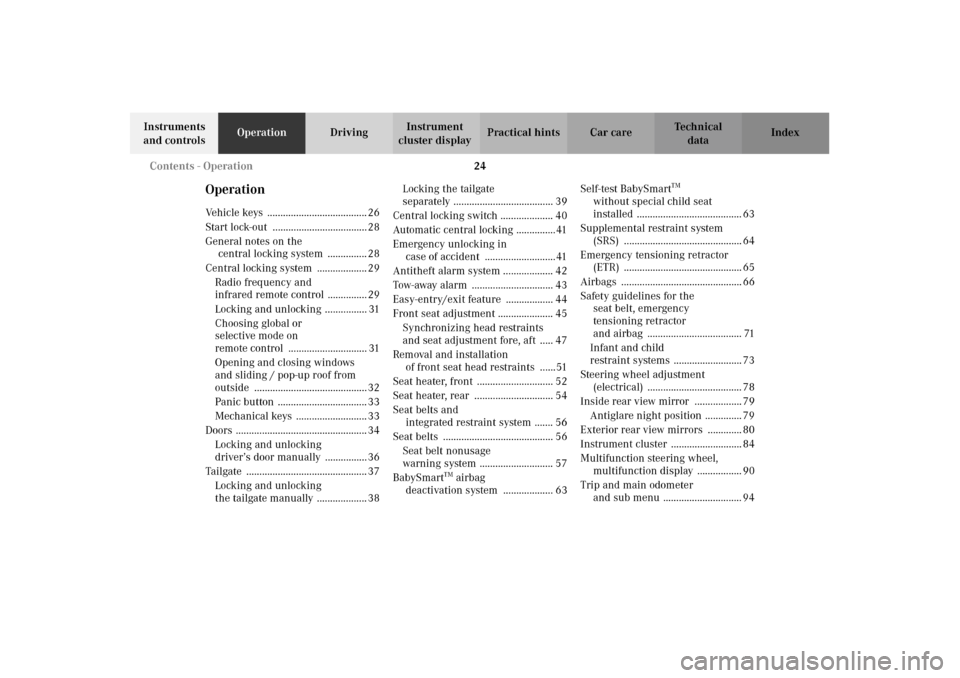
24 Contents - Operation
Te ch n i c a l
data Instruments
and controlsOperationDrivingInstrument
cluster displayPractical hints Car care Index
OperationVehicle keys ...................................... 26
Start lock-out .................................... 28
General notes on the
central locking system ............... 28
Central locking system ................... 29
Radio frequency and
infrared remote control ............... 29
Locking and unlocking ................ 31
Choosing global or
selective mode on
remote control .............................. 31
Opening and closing windows
and sliding / pop-up roof from
outside ........................................... 32
Panic button .................................. 33
Mechanical keys ........................... 33
Doors .................................................. 34
Locking and unlocking
driver’s door manually ................ 36
Tailgate .............................................. 37
Locking and unlocking
the tailgate manually ................... 38Locking the tailgate
separately ...................................... 39
Central locking switch .................... 40
Automatic central locking ............... 41
Emergency unlocking in
case of accident ........................... 41
Antitheft alarm system ................... 42
Tow-away alarm ............................... 43
Easy-entry/exit feature .................. 44
Front seat adjustment ..................... 45
Synchronizing head restraints
and seat adjustment fore, aft ..... 47
Removal and installation
of front seat head restraints ......51
Seat heater, front ............................. 52
Seat heater, rear .............................. 54
Seat belts and
integrated restraint system ....... 56
Seat belts .......................................... 56
Seat belt nonusage
warning system ............................ 57
BabySmart
TM airbag
deactivation system ................... 63Self-test BabySmart
TM
without special child seat
installed ........................................ 63
Supplemental restraint system
(SRS) ............................................. 64
Emergency tensioning retractor
(ETR) ............................................. 65
Airbags .............................................. 66
Safety guidelines for the
seat belt, emergency
tensioning retractor
and airbag .................................... 71
Infant and child
restraint systems .......................... 73
Steering wheel adjustment
(electrical) .................................... 78
Inside rear view mirror .................. 79
Antiglare night position .............. 79
Exterior rear view mirrors ............. 80
Instrument cluster ........................... 84
Multifunction steering wheel,
multifunction display ................. 90
Trip and main odometer
and sub menu .............................. 94
J_G463.book Seite 24 Mittwoch, 19. September 2001 8:06 08
Page 48 of 385
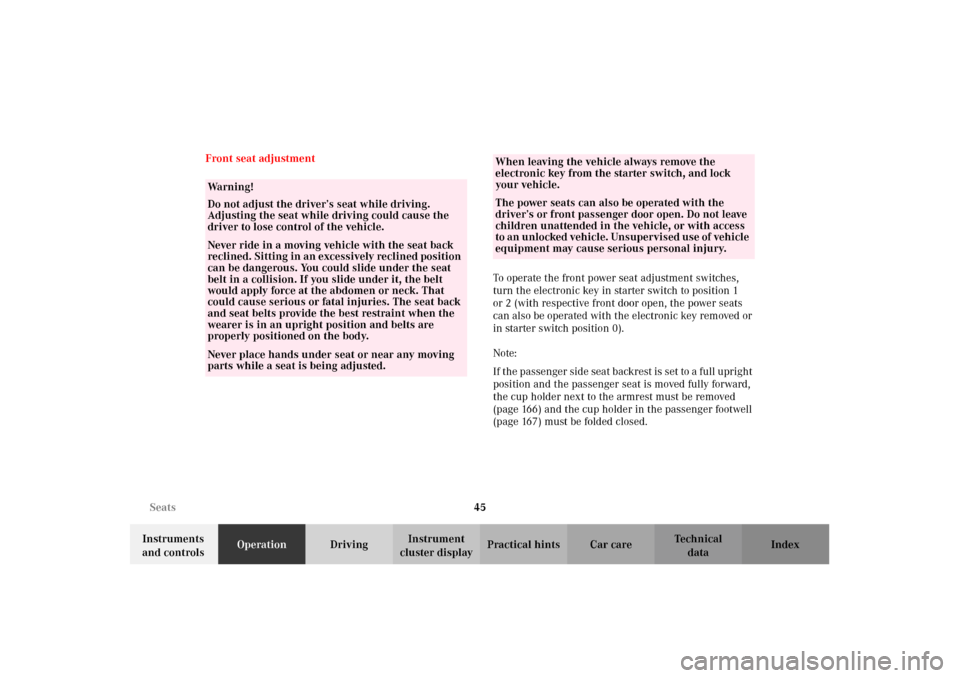
45 Seats
Te ch n i c a l
data Instruments
and controlsOperationDrivingInstrument
cluster displayPractical hints Car care Index Front seat adjustment
To operate the front power seat adjustment switches,
turn the electronic key in starter switch to position 1
or 2 (with respective front door open, the power seats
can also be operated with the electronic key removed or
in starter switch position 0).
Note:
If the passenger side seat backrest is set to a full upright
position and the passenger seat is moved fully forward,
the cup holder next to the armrest must be removed
(page 166) and the cup holder in the passenger footwell
(page 167) must be folded closed.
Wa r n i n g !
Do not adjust the driver’s seat while driving.
Adjusting the seat while driving could cause the
driver to lose control of the vehicle.Never ride in a moving vehicle with the seat back
reclined. Sitting in an excessively reclined position
can be dangerous. You could slide under the seat
belt in a collision. If you slide under it, the belt
would apply force at the abdomen or neck. That
could cause serious or fatal injuries. The seat back
and seat belts provide the best restraint when the
wearer is in an upright position and belts are
properly positioned on the body.Never place hands under seat or near any moving
parts while a seat is being adjusted.
When leaving the vehicle always remove the
electronic key from the starter switch, and lock
your vehicle. The power seats can also be operated with the
driver’s or front passenger door open. Do not leave
children unattended in the vehicle, or with access
to an unl ocked vehic l e. Uns upervi s ed us e of vehi cl e
equipment may cause serious personal injury.
J_G463.book Seite 45 Mittwoch, 19. September 2001 8:06 08
Page 52 of 385
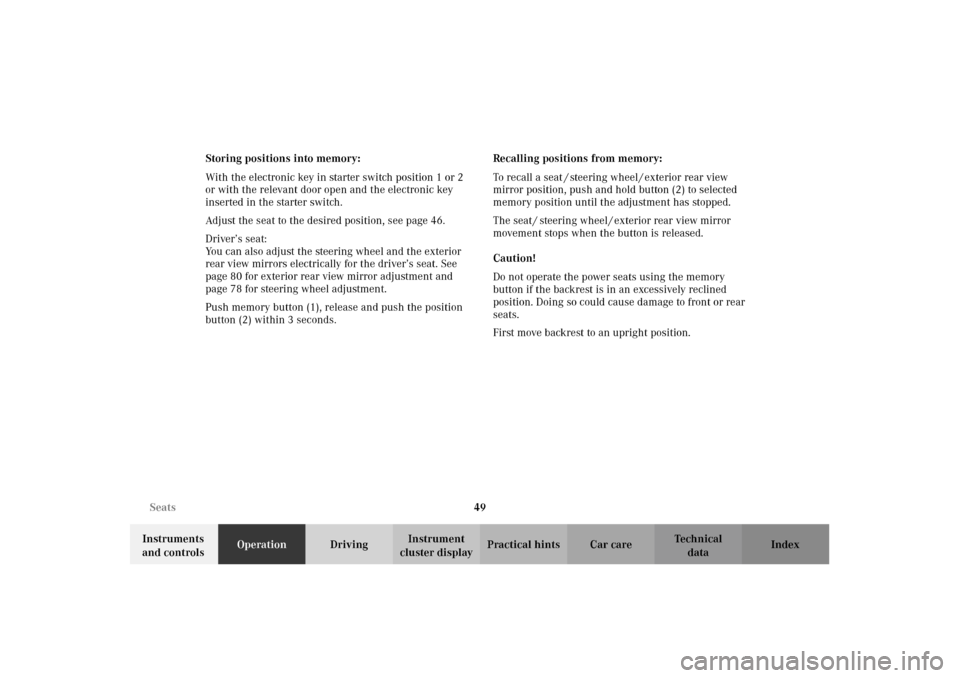
49 Seats
Te ch n i c a l
data Instruments
and controlsOperationDrivingInstrument
cluster displayPractical hints Car care Index Storing positions into memory:
With the electronic key in starter switch position 1 or 2
or with the relevant door open and the electronic key
inserted in the starter switch.
Adjust the seat to the desired position, see page 46.
Driver’s seat:
You can also adjust the steering wheel and the exterior
rear view mirrors electrically for the driver’s seat. See
page 80 for exterior rear view mirror adjustment and
page 78 for steering wheel adjustment.
Push memory button (1), release and push the position
button (2) within 3 seconds.Recalling positions from memory:
To recall a seat / steering wheel / exterior rear view
mirror position, push and hold button (2) to selected
memory position until the adjustment has stopped.
The seat / steering wheel / exterior rear view mirror
movement stops when the button is released.
Caution!
Do not operate the power seats using the memory
button if the backrest is in an excessively reclined
position. Doing so could cause damage to front or rear
seats.
First move backrest to an upright position.
J_G463.book Seite 49 Mittwoch, 19. September 2001 8:06 08
Page 53 of 385
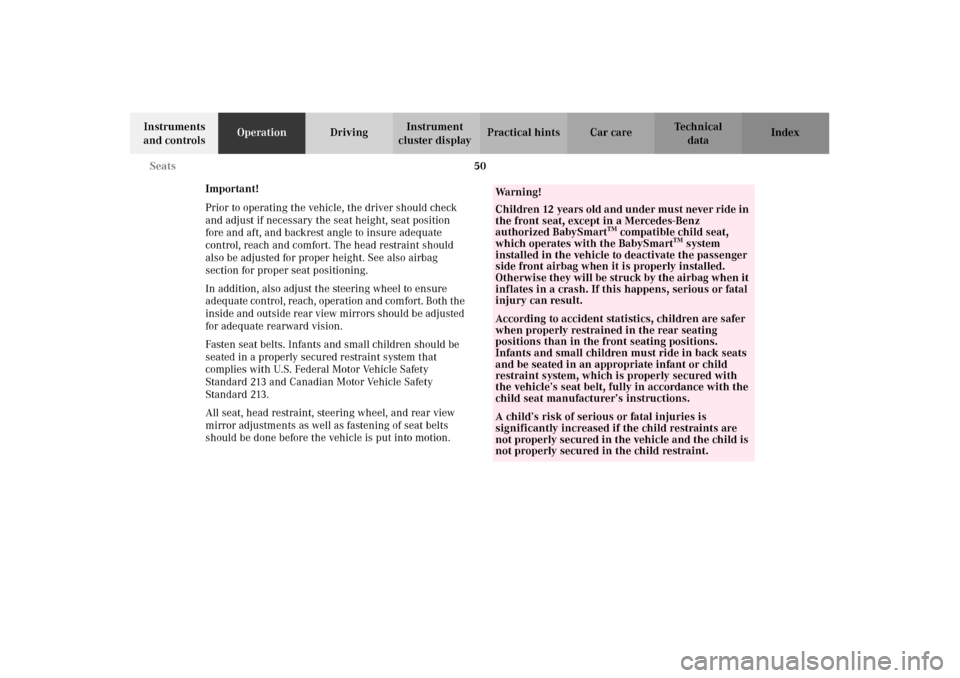
50 Seats
Te ch n i c a l
data Instruments
and controlsOperationDrivingInstrument
cluster displayPractical hints Car care Index
Important!
Prior to operating the vehicle, the driver should check
and adjust if necessary the seat height, seat position
fore and aft, and backrest angle to insure adequate
control, reach and comfort. The head restraint should
also be adjusted for proper height. See also airbag
section for proper seat positioning.
In addition, also adjust the steering wheel to ensure
ad eq uate con tr ol, r each, operation and com fort. B ot h the
inside and outside rear view mirrors should be adjusted
for adequate rearward vision.
Fasten seat belts. Infants and small children should be
seated in a properly secured restraint system that
complies with U.S. Federal Motor Vehicle Safety
Standard 213 and Canadian Motor Vehicle Safety
Standard 213.
All seat, head restraint, steering wheel, and rear view
mirror adjustments as well as fastening of seat belts
should be done before the vehicle is put into motion.
Wa r n i n g !
Children 12 years old and under must never ride in
the front seat, except in a Mercedes-Benz
authorized BabySmart
TM compatible child seat,
which operates with the BabySmart
TM system
installed in the vehicle to deactivate the passenger
side front airbag when it is properly installed.
Otherwise they will be struck by the airbag when it
inflates in a crash. If this happens, serious or fatal
injury can result.
According to accident statistics, children are safer
when properly restrained in the rear seating
positions than in the front seating positions.
Infants and small children must ride in back seats
and be seated in an appropriate infant or child
restraint system, which is properly secured with
the vehicle’s seat belt, fully in accordance with the
child seat manufacturer’s instructions.A child’s risk of serious or fatal injuries is
significantly increased if the child restraints are
not properly secured in the vehicle and the child is
not properly secured in the child restraint.
J_G463.book Seite 50 Mittwoch, 19. September 2001 8:06 08
Page 73 of 385
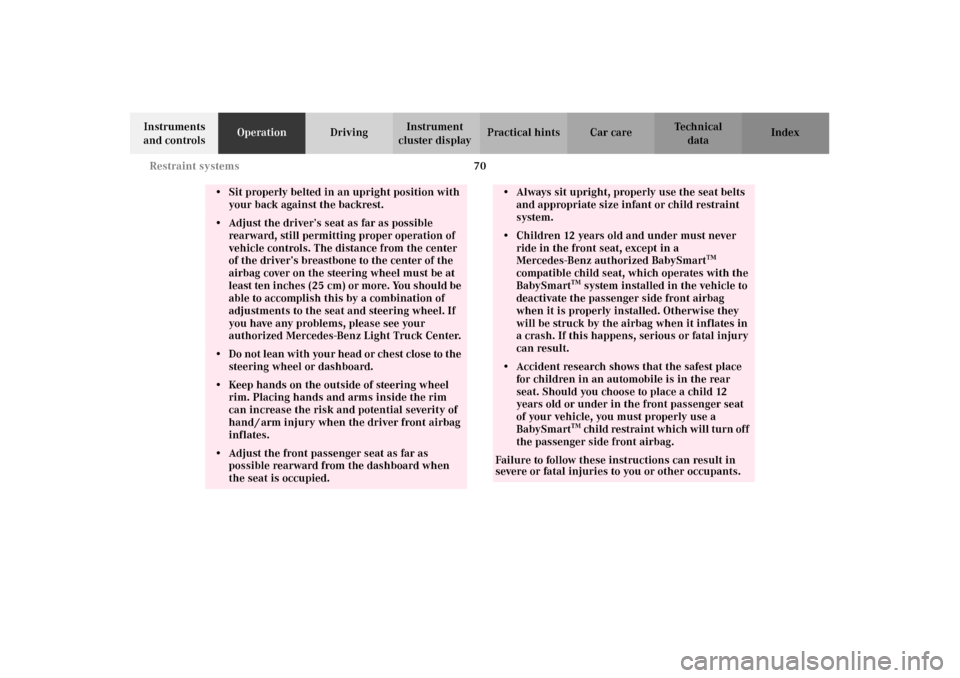
70 Restraint systems
Te ch n i c a l
data Instruments
and controlsOperationDrivingInstrument
cluster displayPractical hints Car care Index
• Sit properly belted in an upright position with
your back against the backrest.• Adjust the driver’s seat as far as possible
rearward, still permitting proper operation of
vehicle controls. The distance from the center
of the driver’s breastbone to the center of the
airbag cover on the steering wheel must be at
least ten inches (25 cm) or more. You should be
able to accomplish this by a combination of
adjustments to the seat and steering wheel. If
you have any problems, please see your
authorized Mercedes-Benz Light Truck Center.• Do not lean with your head or chest close to the
steering wheel or dashboard.• Keep hands on the outside of steering wheel
rim. Placing hands and arms inside the rim
can increase the risk and potential severity of
hand / arm injury when the driver front airbag
inflates.• Adjust the front passenger seat as far as
possible rearward from the dashboard when
the seat is occupied.
• Always sit upright, properly use the seat belts
and appropriate size infant or child restraint
system.• Children 12 years old and under must never
ride in the front seat, except in a
Mercedes-Benz authorized BabySmart
TM
compatible child seat, which operates with the
BabySmart
TM system installed in the vehicle to
deactivate the passenger side front airbag
when it is properly installed. Otherwise they
will be struck by the airbag when it inflates in
a crash. If this happens, serious or fatal injury
can result.
• Accident research shows that the safest place
for children in an automobile is in the rear
seat. Should you choose to place a child 12
years old or under in the front passenger seat
of your vehicle, you must properly use a
BabySmart
TM chi ld restrai nt whi ch w il l turn of f
the passenger side front airbag.
Failure to follow these instructions can result in
severe or fatal injuries to you or other occupants.
J_G463.book Seite 70 Mittwoch, 19. September 2001 8:06 08
Page 81 of 385
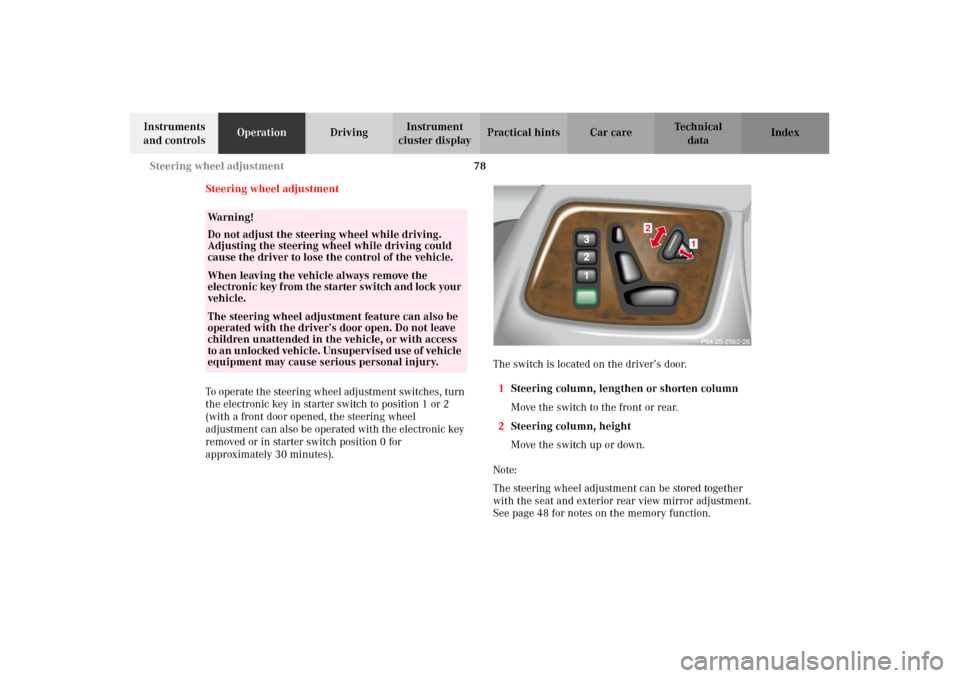
78 Steering wheel adjustment
Te ch n i c a l
data Instruments
and controlsOperationDrivingInstrument
cluster displayPractical hints Car care Index
Steering wheel adjustment
To operate the steering wheel adjustment switches, turn
the electronic key in starter switch to position 1 or 2
(with a front door opened, the steering wheel
adjustment can also be operated with the electronic key
removed or in starter switch position 0 for
approximately 30 minutes).The switch is located on the driver’s door.
1Steering column, lengthen or shorten column
Move the switch to the front or rear.
2Steering column, height
Move the switch up or down.
Note:
The steering wheel adjustment can be stored together
with the seat and exterior rear view mirror adjustment.
See page 48 for notes on the memory function.
Wa r n i n g !
Do not adjust the steering wheel while driving.
Adjusting the steering wheel while driving could
cause the driver to lose the control of the vehicle.When leaving the vehicle always remove the
electroni c key f rom t he sta rter s wi tch a nd lock your
vehicle.The steering wheel adjustment feature can also be
operated with the driver’s door open. Do not leave
children unattended in the vehicle, or with access
to a n un locked vehi cle. Un supervi sed use of vehicl e
equipment may cause serious personal injury.
1
2
2562
J_G463.book Seite 78 Mittwoch, 19. September 2001 8:06 08